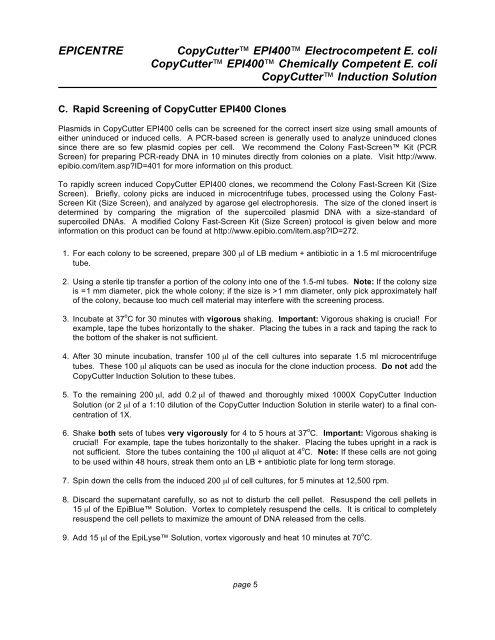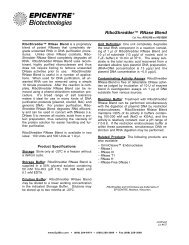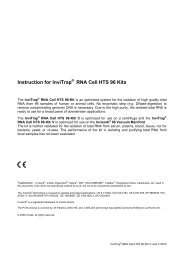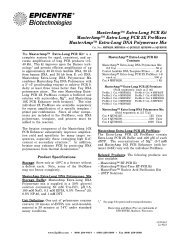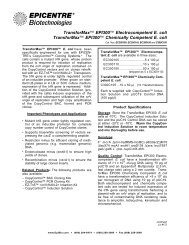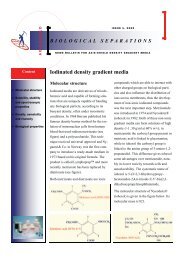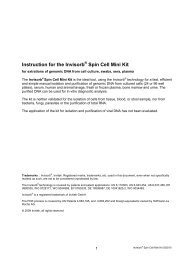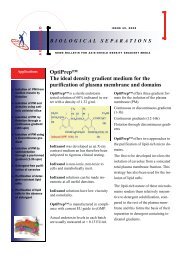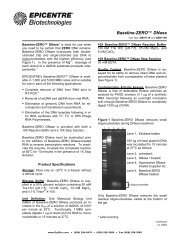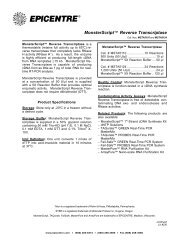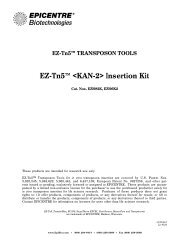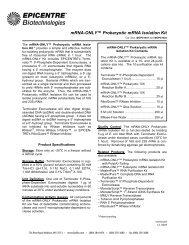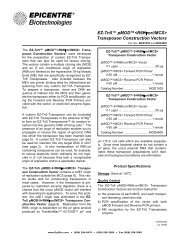Protocol for CopyCutter™ EPI400™ Electrocompetent E. coli ...
Protocol for CopyCutter™ EPI400™ Electrocompetent E. coli ...
Protocol for CopyCutter™ EPI400™ Electrocompetent E. coli ...
Create successful ePaper yourself
Turn your PDF publications into a flip-book with our unique Google optimized e-Paper software.
EPICENTRE<br />
CopyCutter EPI400 <strong>Electrocompetent</strong> E. <strong>coli</strong><br />
CopyCutter EPI400 Chemically Competent E. <strong>coli</strong><br />
CopyCutter Induction Solution<br />
C. Rapid Screening of CopyCutter EPI400 Clones<br />
Plasmids in CopyCutter EPI400 cells can be screened <strong>for</strong> the correct insert size using small amounts of<br />
either uninduced or induced cells. A PCR-based screen is generally used to analyze uninduced clones<br />
since there are so few plasmid copies per cell. We recommend the Colony Fast-Screen Kit (PCR<br />
Screen) <strong>for</strong> preparing PCR-ready DNA in 10 minutes directly from colonies on a plate. Visit http://www.<br />
epibio.com/item.asp?ID=401 <strong>for</strong> more in<strong>for</strong>mation on this product.<br />
To rapidly screen induced CopyCutter EPI400 clones, we recommend the Colony Fast-Screen Kit (Size<br />
Screen). Briefly, colony picks are induced in microcentrifuge tubes, processed using the Colony Fast-<br />
Screen Kit (Size Screen), and analyzed by agarose gel electrophoresis. The size of the cloned insert is<br />
determined by comparing the migration of the supercoiled plasmid DNA with a size-standard of<br />
supercoiled DNAs. A modified Colony Fast-Screen Kit (Size Screen) protocol is given below and more<br />
in<strong>for</strong>mation on this product can be found at http://www.epibio.com/item.asp?ID=272.<br />
1. For each colony to be screened, prepare 300 µl of LB medium + antibiotic in a 1.5 ml microcentrifuge<br />
tube.<br />
2. Using a sterile tip transfer a portion of the colony into one of the 1.5-ml tubes. Note: If the colony size<br />
is = 1 mm diameter, pick the whole colony; if the size is > 1 mm diameter, only pick approximately half<br />
of the colony, because too much cell material may interfere with the screening process.<br />
3. Incubate at 37 o C <strong>for</strong> 30 minutes with vigorous shaking. Important: Vigorous shaking is crucial! For<br />
example, tape the tubes horizontally to the shaker. Placing the tubes in a rack and taping the rack to<br />
the bottom of the shaker is not sufficient.<br />
4. After 30 minute incubation, transfer 100 µl of the cell cultures into separate 1.5 ml microcentrifuge<br />
tubes. These 100 µl aliquots can be used as inocula <strong>for</strong> the clone induction process. Do not add the<br />
CopyCutter Induction Solution to these tubes.<br />
5. To the remaining 200 µl, add 0.2 µl of thawed and thoroughly mixed 1000X CopyCutter Induction<br />
Solution (or 2 µl of a 1:10 dilution of the CopyCutter Induction Solution in sterile water) to a final concentration<br />
of 1X.<br />
6. Shake both sets of tubes very vigorously <strong>for</strong> 4 to 5 hours at 37 o C. Important: Vigorous shaking is<br />
crucial! For example, tape the tubes horizontally to the shaker. Placing the tubes upright in a rack is<br />
not sufficient. Store the tubes containing the 100 µl aliquot at 4 o C. Note: If these cells are not going<br />
to be used within 48 hours, streak them onto an LB + antibiotic plate <strong>for</strong> long term storage.<br />
7. Spin down the cells from the induced 200 µl of cell cultures, <strong>for</strong> 5 minutes at 12,500 rpm.<br />
8. Discard the supernatant carefully, so as not to disturb the cell pellet. Resuspend the cell pellets in<br />
15 µl of the EpiBlue Solution. Vortex to completely resuspend the cells. It is critical to completely<br />
resuspend the cell pellets to maximize the amount of DNA released from the cells.<br />
9. Add 15 µl of the EpiLyse Solution, vortex vigorously and heat 10 minutes at 70 o C.<br />
page 5


